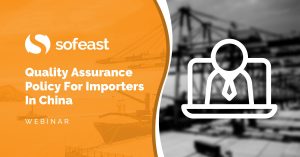
A reader asked me how he should do an inspection of a lot produced in isolation. In theory, he should work with the Limiting Quality Level (LQ), not the AQL, which is designed for inspections of a continuous stream of production.
I shot a video to contrast the 2 approaches, explain when each makes sense, and show how each works.
Using the AQL vs. the LQ (Limiting Quality Level) for product inspections
Here is a video explanation of these 2 concepts:
I hope it’s clear now. Choosing ISO 2859-1 vs. ISO 2859-2 comes with MASSIVE implications for the supplier. A not-very-good-quality batch is much more likely to get rejected if the LQ (under ISO 2859-2) is used.
Typical inspection plans with sampling and acceptance rules based on the concept of AQL
Most inspections of product batches are done based on the AQL. (Outside of certain industries, like automotive, which consider it a very lax approach and prefer to focus on process controls and acceptance on zero sampling plans.)
Inspections based on AQL are supposed to be used when a succession of batches coming out of the same unchanged process are inspected, for example on arrival.
ISO 28590:2017, which explains what acceptance sampling plan makes sense for what situation, puts it this way:
ISO 2859-1 is an acceptance sampling system indexed by the acceptance quality limit (AQL). It is widely used for various purposes, but it was originally designed for the inspection of a continuing series of lots where switching rules are employed.
Another type of inspection plan, based on the concept of LQ
The same ISO 28590:2017 standard explains:
there are situations where the switching rules of ISO 2859-1 are not applicable, such as when lots are isolated. ISO 2859-2 is designed for such situations.
OK, so what is replacing the AQL in that case?
LQ stands for limiting quality. It is the quality level, for a lot in isolation, which, for the purpose of sampling inspection, is limited to a low probability of acceptance.
The tables and all the information needed to use this type of sampling plan are in the ISO 2859-2:2020 standard.
Can the AQL really NOT be used for inspections of isolated batches?
Yes, it can. The standard says it’s OK, but the parties need to be aware that it is likely to lead to a bad batch being accepted.
The AQL is a fairly well-known concept, while few people have heard of the Limiting Quality level. It is often difficult to explain to suppliers that an entirely new, and mostly unheard of, tool is going to be used to decide if their products can be accepted… That’s why most buyers stick with the AQL, often to their detriment.
*****
Do you have any questions about LQ vs AQL? How about product inspections in general? If something is bugging you, let me know by commenting or contacting me. I’ll be happy to help!
P.S. Read these resources next…
- The Different Types Of Sampling Plans For QC Inspections
- Limits of QC inspections based on AQL & random sampling
- How The AQL Inspection Levels In ISO 2859-1 Affect Sampling Size
- AQL Calculator
- How To Choose Which Product Quality inspection You Need?
Quality Assurance Policy For Importers In China [Webinar]
What is the 80/20 rule when it comes to QC in China? The answer is building a strong quality assurance policy of your own.
In this webinar, we’re going to explore key challenges facing importers from China, and the elements that compose a really solid, effective quality assurance policy.
Improving your quality assurance will help avoid poor-quality products from hurting your business. Hit the button below to register to watch the webinar!

